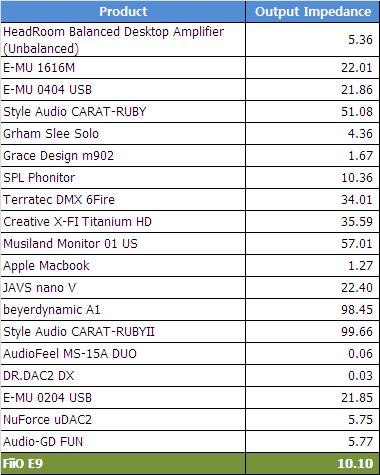Porter_
[H]F Junkie
- Joined
- Sep 10, 2007
- Messages
- 8,467
last night i bought a used JDS Labs O2 Headphone Amp from a head-fi'er that lives local to me. my DT770 Pro 80's aren't particularly hard to drive but after reading NwAvGuy's Headphone & Amp Impedance article i became curious about the theory behind the 1/8th rule. for the lazy:
this is a new concept for me, i started reading about it a couple days ago. according to goldenears.net the titanium HD has an output impedance of 35.6 ohms:

my DT770's are rated at 80 ohms and verified by NwAvGuy (measured at a low of 83 ohms) so going by the 1/8th rule i'd need a source with an output impedance of 10 ohms or less. with my DT770's connected directly to my Titanium HD i have a damping factor of 2.33 instead of the desired 8 or more. the O2 is measured at an output impedance of 0.54 ohms so that gives a damping factor of 153.7. i was lucky enough to find a used O2 local to me at a reasonable price so i took the plunge to see for myself.



the previous chain was: Titanium HD headphone out -> DT770
the new chain is: Titanium HD RCA out -> O2 -> DT770
I want to make that distinction before i start gushing about the O2; i swapped from the headphone out on the Titanium HD to the RCA out. i don't know what effect this has if any. also i'm just a guy sitting at my desk comparing. i haven't performed a blind level-matched ABX test or anything like that.
gushing: very surprised to hear an audible difference! the bass is very controlled and responsive now. i didn't realize how muddy it was. treble sounds nice and smooth but really i notice the difference in the lower frequencies the most. i don't hear anything crazy like the soundstage opening up (some have said this), that sounds exactly the same to my ears. after reading NwAvGuy's impedance article i had my doubts about the theory behind damping factor and if it would actually come to fruition for me (my hearing wouldn't be good enough to notice it, etc.). i read the impedance article before i picked up the O2 so the idea of 'expectation bias' comes into play (also a good NwAvGuy article). and it's still a new shiny toy. regardless, there is a very audible and real difference.
wanted to share my still-new-to-me experience with the O2 amp
NwAvGuy said:All you really need to know is most headphones work best when the output impedance is less than 1/8th the headphone impedance. So, for example, with 32 ohm Grados the output impedance can be, at most, 32/8 = 4 ohms. The Etymotic HF5s are 16 ohms so the max output impedance is 16/8 = 2 ohms. If you want to be assured a source will work well with just about any headphone, simply make sure the output impedance is under 2 ohms.
this is a new concept for me, i started reading about it a couple days ago. according to goldenears.net the titanium HD has an output impedance of 35.6 ohms:

my DT770's are rated at 80 ohms and verified by NwAvGuy (measured at a low of 83 ohms) so going by the 1/8th rule i'd need a source with an output impedance of 10 ohms or less. with my DT770's connected directly to my Titanium HD i have a damping factor of 2.33 instead of the desired 8 or more. the O2 is measured at an output impedance of 0.54 ohms so that gives a damping factor of 153.7. i was lucky enough to find a used O2 local to me at a reasonable price so i took the plunge to see for myself.



the previous chain was: Titanium HD headphone out -> DT770
the new chain is: Titanium HD RCA out -> O2 -> DT770
I want to make that distinction before i start gushing about the O2; i swapped from the headphone out on the Titanium HD to the RCA out. i don't know what effect this has if any. also i'm just a guy sitting at my desk comparing. i haven't performed a blind level-matched ABX test or anything like that.
gushing: very surprised to hear an audible difference! the bass is very controlled and responsive now. i didn't realize how muddy it was. treble sounds nice and smooth but really i notice the difference in the lower frequencies the most. i don't hear anything crazy like the soundstage opening up (some have said this), that sounds exactly the same to my ears. after reading NwAvGuy's impedance article i had my doubts about the theory behind damping factor and if it would actually come to fruition for me (my hearing wouldn't be good enough to notice it, etc.). i read the impedance article before i picked up the O2 so the idea of 'expectation bias' comes into play (also a good NwAvGuy article). and it's still a new shiny toy. regardless, there is a very audible and real difference.
wanted to share my still-new-to-me experience with the O2 amp
Last edited:
![[H]ard|Forum](/styles/hardforum/xenforo/logo_dark.png)
